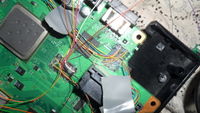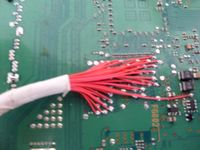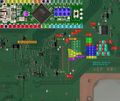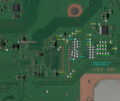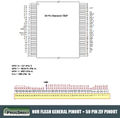Hardware flashing
Both early launch consoles which feature NAND flash memory (block devices, that interleave their data unlike NOR flash) and later consoles which feature NOR flash memory are able to be flashed. Currently the preferred method of flashing the dual-NAND consoles is by using an infectus modchip or similar (e.g. Progskeet).
Marcan has made a NOR flasher / address sniffer for his PS3 slim by re-purposing a FPGA board (Xilinx Spartan3E XC3S500E) made for Wii hacking. noralizer is a git repo that contains the HDL (verilog) and associated host computer tools for flashing/sniffing. There are ~50 signals to solder.
Work has been underway to brink a low cost AVR (Atmel 90USB1286) based NOR flasher that is capable of reading and writing on all consoles by defyboy. Other people havent been sitting idle either: uf6667 and Icekiller have developed Progskeet, based on a Actel A3P125 MCU for NAND ánd NOR based consoles and "no_one" has developed PNM - Project Nor Manager.
NAND Wiring
Flashers for NAND based consoles (CECHA/COK-001, CECHB/COK-001, CECHC/COK-002, CECHD/unreleased, CECHE/COK-002W, CECHF/unreleased, CECHG/SEM-001) are generaly wired directly to the pins of the NAND, plus ground and Vcc. For NAND pinouts see: Flash (Hardware) #NAND
There are 2 nands interleaved at the 512byte sectors level, giving a 1024 byte "interleaved sector". pages are 2kb on each nand.
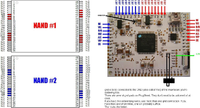
| Chip/PIN | Description | Progskeet | Infectus | Description |
|---|---|---|---|---|
| NAND 0 | ||||
| 0/1-6 | NC | NC | NC | No Connection |
| 0/7 | R/B | 3 / gp13 | A9 | Read/Busy Output |
| 0/8 | RE | 98 / gp15 | A15 | Read Enable |
| 0/9 | CE | 7 / gp9 | A14 | Chip Enable |
| 0/10+11 | NC | NC | NC | No Connection |
| 0/12 | Vcc | +3.3 | not used / not connected | Vcc (min 2.7V-max 3.6V / typ 3.3V) |
| 0/13 | Vss | GND | not used / not connected | VSS - Ground |
| 0/14+15 | NC | NC | NC | No Connection |
| 0/16 | CLE | 4 / gp12 | A13 | Command Latch Enable |
| 0/17 | ALE | 5 / gp11 | A12 | Address Latch Enable |
| 0/18 | WE | 2 / gp14 | A11 | Write Enable |
| 0/19 | WP | 6 / gp10 | A10 | Write Protect |
| 0/20-28 | NC | NC | NC | No Connection |
| 0/29 | I/O-0 | 90 / dq8 | A0 | |
| 0/30 | I/O-1 | 91 / dq9 | A1 | |
| 0/31 | I/O-2 | 92 / dq10 | A2 | |
| 0/32 | I/O-3 | 93 / dq11 | A3 | |
| 0/33-35 | NC | NC | NC | No Connection |
| 0/36 | Vss | GND | not used / not connected | VSS - Ground |
| 0/37 | Vcc | +3.3 | not used / not connected | Vcc (min 2.7V-max 3.6V / typ 3.3V) |
| 0/38-40 | NC | NC | NC | No Connection |
| 0/41 | I/O-4 | 94 / dq12 | A4 | |
| 0/42 | I/O-5 | 95 / dq13 | A5 | |
| 0/43 | I/O-6 | 96 / dq14 | A6 | |
| 0/44 | I/O-7 | 97 / dq15 | A7 | |
| 0/45-48 | NC | NC | NC | No Connection |
| Chip/PIN | Description | Progskeet | Infectus | Description |
| NAND 1 | ||||
| 1/1-6 | NC | NC | NC | No Connection |
| 1/7 | R/B | 64 / rdy | U | Read/Busy Output |
| 1/8 | RE | 69 / oe | M | Read Enable |
| 1/9 | CE | 60 / gp3 | N | Chip Enable |
| 1/10+11 | NC | NC | NC | No Connection |
| 1/12 | Vcc | +3.3 | not used / not connected | Vcc (min 2.7V-max 3.6V / typ 3.3V) |
| 1/13 | Vss | GND | not used / not connected | VSS - Ground |
| 1/14+15 | NC | NC | NC | No Connection |
| 1/16 | CLE | 63 / gp0 | O | Command Latch Enable |
| 1/17 | ALE | 62 / gp1 | P | Address Latch Enable |
| 1/18 | WE | 65 / we | Q | Write Enable |
| 1/19 | WP | 61 / gp2 | T | Write Protect |
| 1/20-28 | NC | NC | NC | No Connection |
| 1/29 | I/O-0 | 79 / dq0 | D0 | |
| 1/30 | I/O-1 | 80 / dq1 | D1 | |
| 1/31 | I/O-2 | 81 / dq2 | D2 | |
| 1/32 | I/O-3 | 82 / dq3 | D3 | |
| 1/33-35 | NC | NC | NC | No Connection |
| 1/36 | Vss | GND | not used / not connected | VSS - Ground |
| 1/37 | Vcc | +3.3 | not used / not connected | Vcc (min 2.7V-max 3.6V / typ 3.3V) |
| 1/38-40 | NC | NC | NC | No Connection |
| 1/41 | I/O-4 | 83 / dq4 | D4 | |
| 1/42 | I/O-5 | 84 / dq5 | D5 | |
| 1/43 | I/O-6 | 85 / dq6 | D6 | |
| 1/44 | I/O-7 | 86 / dq7 | D7 | |
| 1/45-48 | NC | NC | NC | No Connection |
| Board trace | ||||
| GND | Vss | not used / not connected | GND | VSS - Ground |
| +5V | Vcc | not used / not connected | 5V | Vcc (typ +5VDC) from TH3401 |
Remarks:
- Progskeet is feeded from NAND 3.3V
- Infectus is feeded from +5V board trace.
- NAND's are feeded in both cases by the console itself.
Progskeet Note: Some modification is needed for Progskeet to unbrick:
- desolder R8 from the Progskeet PCB (to disable the connection from pad R8 to left pad R7)
- left pin of switch to left lead of R7, middle pin of switch to right lead of R7
- Vcc to +3.3 // put switch in "OFF" (right) postion, power on the ps3, put the switch in the "ON"/left position, it will be recognized by the PC, NAND is always on now, do everything as usual.
Using NAND flashers
Progskeet
... nothing yet ... please help by adding this :)
put switch in "OFF" (R7 is open) position so that progskeet is not powered. power on the ps3 and wait for 20-25 seconds, put the switch in the "ON" (R7 closed) position, so progskeet is powered and will be recognized by the PC. NAND is always on now, do everything as usual
select Big Block select Raw Pages per block: 64 blocks: 1024
That will give you 132MB (138,412,032 bytes) per NAND (dump time ~ 00:02:40 per NAND)
downloads
All downloads are available here
- diagrams - for PS3: see above, but others are available here: diagrams_110805.rar (backup/mirror: diagrams_110803.rar (4.76 MB))
- drivers - diagrams_110804.rar (mirror: diagrams_110804.rar (9.73 MB))
- flasher software - ProgSkeet_110807.rar (mirror: ProgSkeet_110807.rar (29.24 KB)
Infectus
For Infectus don't use 3.9.9.0, as it removes dual NAND PS3 support :S If your board already came with this version or higher, use this: prepare_infectus_for_ps3.rar (5.53 MB) If it is done, it will show up as "2 NAND Programmer" in the bottom left. Dual NAND PS3 compatible version: Infectus_programmer_3.8_Beta_2.zip (4.02 MB)
Power the Infectus, it crashes the PS3 and leaves the NANDs in powered mode. Use the console to power the NANDs: power it up until the PS3 crashes and halts with red flashing LED, press power again to stop the flashing, but keeps the console powered on. The NANDs are not accessed by the PS3 in this way, so it doesn't matter if the NAND content is already messed up. After that, you can read/write the NANDs.
Dumping of single NAND should take about 15 minutes, 30 minutes for both.
Needed NAND tools
In case the flasher program doesnt understand dual NAND de/interleaving you'll need : FlowRebuilder v.4.1.0.0
Dump NAND from GameOS
dump_flash.pkg // backup/mirror: dump-flash+syscon.rar (280.51 KB)
Make sure USB stick is FAT32 with enough free space (256MB per dump)
Difference between hardware dumps and software dumps
ps3vflasha
hardware dumps
256 MB (268,435,456 bytes) bootldr is at 0x000000 on NAND (0xFC0000 on NOR)
software dumps
dump size = 239 MB (251,396,096 bytes)
bootldr not at 0x000000 on NAND :
00000000 00 00 00 00 00 00 00 00 00 00 00 00 00 00 00 00 ................ 00000010 00 00 00 00 0F AC E0 FF 00 00 00 00 DE AD BE EF .....¬à ÿ....Þ¾ï
reason:
addi %r12, %r4, 0x200 # r4 = start sector
25MB NAND consoles have a hidden section of size 0x40000 (0x200 * 512 byte sector = 0x40000) hidden by the hv. The hv hides it at address 002786E8
Original code : 0x39840200f8010090
Change to : 0x39840000f8010090
Too dangerous to patch unless you peek/poke because obviously it messes with all the offsets
'NOR' Interface Testpoints on NAND consoles
Simular as on the NOR based consoles testpoints can be found on the back of the PCB. It seems these are from the bus between the South Bridge and the Starship2. Attempts have been made to document/trace these. Addresslines 0-17 and Datalines 0-15 as well as some controllines are documented but so far these could not be used to read/flash the console in a NOR fashion.
NOR Interface Testpoints
Probably to aid in factory programming, Sony provides NOR testpoints on the bottomside of the motherboard. There are 16 data lines (Word access) and generally 23 Address lines. You will also need to control Chip Enable (#CE), Write Enable (#WE), Tristate (SB_DISABLE) and for some boards Write Protect (#WP)
Tristate
Tristate, or as it is referred to in the service manuals SB_DISABLE exists solely for the purpose of placing the South Bridge pins into high-impedance (the third state) so that we can access the flash without the South Bridge interfering.
Because the tristate pin is not connected to the NOR flash TSOP package, but to the South Bridge BGA package, this makes tracing the pin quite difficult. One should be able to locate it by having the running you could ground out the unknown pins whilst checking the continuity of a known address or data line against ground. These should enter high-impedance or no-continuity when you ground out SB_DISABLE.
Connecting NOR pads to flasher
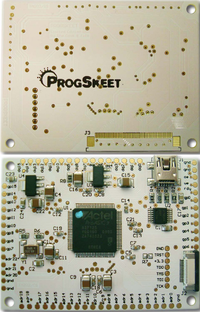
| PAD | Progskeet | Teensy2.0++ NORway |
|
|---|---|---|---|
| A0 | adr0 | F0 | |
| A1 | adr1 | F1 | |
| A2 | adr2 | F2 | |
| A3 | adr3 | F3 | |
| A4 | adr4 | F4 | |
| A5 | adr5 | F5 | |
| A6 | adr6 | F6 | |
| A7 | adr7 | F7 | |
| A8 | adr8 | PA0 | |
| A9 | adr9 | PA1 | |
| A10 | adr10 | PA2 | |
| A11 | adr11 | PA3 | |
| A12 | adr12 | PA4 | |
| A13 | adr13 | PA5 | |
| A14 | adr14 | PA6 | |
| A15 | adr15 | PA7 | |
| A16 | adr16 | B0 | |
| A17 | adr17 | B1 | |
| A18 | adr18 | B2 | |
| A19 | adr19 | B3 | |
| A20 | adr20 | B4 | |
| A21 | adr21 | B5 | |
| A22 | adr22 | B6 | |
| DQ0 | dq0 | D0 | |
| DQ1 | dq1 | D1 | |
| DQ2 | dq2 | D2 | |
| DQ3 | dq3 | D3 | |
| DQ4 | dq4 | D4 | |
| DQ5 | dq5 | D5 | |
| DQ6 | dq6 | D6 | |
| DQ7 | dq7 | D7 | |
| DQ8 | dq8 | C0 | |
| DQ9 | dq9 | C1 | |
| DQ10 | dq10 | C2 | |
| DQ11 | dq11 | C3 | |
| DQ12 | dq12 | C4 | |
| DQ13 | dq13 | C5 | |
| DQ14 | dq14 | C6 | |
| DQ15 | dq15 | C7 | |
| #WE | we | E5 | |
| CE# | gp0 | E0 | |
| RESET | gp1 | E4 | |
| TRISTATE | gp2 | E7 | |
| WP# | gp3 | ?tied to Vcc? | |
| OE# | oe | E1 | |
| RY/BY# | rdy | E6 | |
| VSS | GND | GND |
Progskeet Note: Some modification is needed for Progskeet to unbrick:
- desolder R8 from the Progskeet PCB
- left pin of switch to left lead of R7, middle pin of switch to right lead of R7
- Vcc to +3.3 // put switch in "OFF" (right) postion, power on the ps3, put the switch in the "ON"/left position, it will be recognized by the PC, NOR is always on now, do everything as usual.
Notes: The Teensy requires a 3.3V voltage regulator! 5V trace has to be cut and 3V pads have to be shorted! Please refer to https://www.pjrc.com/teensy/3volt.html
Performance Teensy: 0:00:45 for a full dump/read (364 KB/s), 0:00:05.351 per sector write or 0:08:19 for a full write (32,83 KB/s) // Comparison with Progskeet: 0:00:16 for a full dump/read (~1MB/s), 0:00:00.365 per sector write or 0:00:46.811 for a full write (~300-400KB/s).
Using NOR flashers
Progskeet
take the cable out the back plug it back in put the switch on "off" power on wait 10 seconds put the switch on "on" dump 128kB sector, 128 sectors
Needed NOR tools
- norunpack (usage: norunpack dump.b directory) git: http://git.dashhacks.com/ps3free/ps3tools
Dump NOR from GameOS
dump_flash.pkg // backup/mirror: dump-flash+syscon.rar (280.51 KB)
Make sure USB stick is FAT32 with enough free space (16MB per dump)
Board Revisions
COK-001, COK-002, SEM-001
These are the earliest revisions of the PS3 motherboard (CECHA, CECHB, CECHC, CECHE, CECHG) and contain 2 x Samsung K9F1G08U0A-PIB0 128MB NAND Chips for a total of 256MB. These chips are interleaved which is controlled by a proprietary controller chip codenamed "Starship2" or SS2. This chip handles the interleaving and presents the NAND Chips to the South Bridge as a single large coherent NOR Chip.
DIA-001, DIA-002
These boards were the first to get the NOR flash memory from the middle revisions of the PS3 (CECHH, CECHJ, CECHK). Only a single Spansion S29GL128N90TFIR2 16MB NOR flash chip is used and the Starship2 chip has been completely removed. The 128N is JEDEC CFI compliant and organized as 8,388,608 words or 16,777,216 bytes, addressable as 16-bit words (PS3 modus operandi) and 8-bit / 1 byte when the BYTE# signal is logic zero.
VER-001
Used in the last revisions of the fatter model PS3 (CECHL, CECHM, CECHP, CECHQ), again with the single Spansion S29GL128N90TFIR2 16MB NOR flash with the exception of the CECHL which used a Samsung K8Q2815UQB-P14B 16MB NOR flash.
JSD-001
This is the pinout originally supplied by Marcan for a CECH-2504A, Points match those taken from a CECH-2504B slim console. Most slims may carry this arrangement.
Pinout Gallery
- JTP-001 - 1-882-481-21-testpoints.jpg
JTP-001 NOR Testpoints (not mapped)
- Ver-001 nor.jpg
VER-001 NOR Testpoints (trisaster.de, missing TRISTATE)
Missing / requested :
- COK-002 (NAND)
- COK-002W (NAND)
- SEM-001 (NAND)
- DIA-002 (NOR)
- SUR-001 (NOR) some difference in components of JSD-001, need tracing (confirmed not reading/writing using the JSD-001 wiring with ProgSkeet)
- JTP-001 (NOR) seems visually the same as JSD-001, but need tracing+confirmation
- KTE-001 (NOR)
Generic wire reference
Wire thickness AWG/mm :
18 AWG - .0403" / 1.024mm 20 AWG - .0320" / 0.812mm 22 AWG - .0253" / 0.644mm 24 AWG - .0201" / 0.511mm 26 AWG - .0159" / 0.405mm 28 AWG - .0126" / 0.321mm 30 AWG - .0100" / 0.255mm
For wiring, use 20-26 AWG. 18 can be too stiff while 28 is too fragile. 24 AWG works fine in most cases. The Ground and VCC wires may ofcourse be thicker than the signal wires.
Generic unresolved issues
- (user:sel99) : CECHG / SEM-001 - 1-875-384-31 - can dump both NANDs fine, have trouble writing - both with Infectus and Progskeet. Boards below CECHG / SEM-001 flash fine. Others having the same issues?
Progskeet QA/problem solving
Generic advice
Be up to date
Always make sure you used the latest diagrams, drivers and flasher software from progskeet.com
No shorts
Before doing anything, make 100% sure you wired up everything correct (no address/data IO lines mixed? all controllines hooked up? power/ground in order? etc.) and no shorts are made where there should not.
Error : libusb0.dll or libusb0.sys not found
The libusb-win32 Kernel Driver needed for the the flasher to get access to the USB port was not installed. Make sure you unpacked the drivers_xxxxxx file and installed the Progskeet driver (VendorID:1988 / ProductID:0001 in case you need it).
Error : side-by-side configuration is incorrect
In case of "the application has failed to start because its side-by-side configuration is incorrect" make sure Microsoft Visual C 9.0 runtime is installed and "Windows Installer" is not disabled (set to manual or automatic) in Services.msc
Error : incorrect parameter
Make sure you selected the correct values for your NOR/NAND device. E.g. :
- NOR: 128kB sector, 128 sectors
- NAND: select Big Block, select Raw, Pages per block: 64, blocks: 1024
